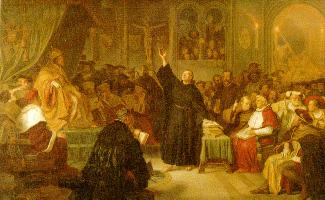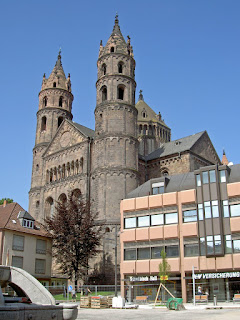 The town was laid out as a cross according to medieval planning, with the churches of St. Michael, St. Stephen, St. Gangolf, and St. Jacob at the four cardinal points. It was intended to be a second Rome and Henry II ruled here from 1002 to 1024. He was buried along with the only Pope buried outside of Rome. He was the last Roman Emperor of the Ottonian Dynasty, ruled Italy and Germany and is the only German king to be canonized. He lead numerous campaigns on their behalf as a strong advocate of the Catholic church and its efforts to christianize much of Europe.
The town was laid out as a cross according to medieval planning, with the churches of St. Michael, St. Stephen, St. Gangolf, and St. Jacob at the four cardinal points. It was intended to be a second Rome and Henry II ruled here from 1002 to 1024. He was buried along with the only Pope buried outside of Rome. He was the last Roman Emperor of the Ottonian Dynasty, ruled Italy and Germany and is the only German king to be canonized. He lead numerous campaigns on their behalf as a strong advocate of the Catholic church and its efforts to christianize much of Europe. The city prospered in the following centuries and subsequent efforts to retain its heritage in architecture, planning and aesthetic appeal allowed us to take in an impressive display of art in a variety of forms. We explored street after street, taking in the grand old churches, some over a thousand years old, palatial residences, beautiful gardens and splendid examples of medieval planning and architecture. I was anxious to make the most of the day and Arendje had to constrain me several times or I would have left my travelling companions far behind.
The city prospered in the following centuries and subsequent efforts to retain its heritage in architecture, planning and aesthetic appeal allowed us to take in an impressive display of art in a variety of forms. We explored street after street, taking in the grand old churches, some over a thousand years old, palatial residences, beautiful gardens and splendid examples of medieval planning and architecture. I was anxious to make the most of the day and Arendje had to constrain me several times or I would have left my travelling companions far behind.I counted 14 museums in total, devoted to everything from market gardeners and wine growers to a missionary museum. There was a royal Strasbourg porcelain collection to a fire brigade museum. We did not have time to venture into any. There was too much to see outside. We got a little wet, but not enough to dampen our spirits. The Taylor's are beginning to think there is no such thing as sunshine in Germany on a Saturday.
 The city of Bamberg is built on seven hills as was Rome and so we got our exercise hiking up and down to take in the landmark sites. This trip acquired its standing amongst the best sites for their number and grandeur. Each church captured our attention, as each maintained its integrity by incorporating diverse forms of art, architecture and layout.
The city of Bamberg is built on seven hills as was Rome and so we got our exercise hiking up and down to take in the landmark sites. This trip acquired its standing amongst the best sites for their number and grandeur. Each church captured our attention, as each maintained its integrity by incorporating diverse forms of art, architecture and layout.The Imperial Cathedral to the right housed impressive rock sculptures and the tomb of Pope Clemens II in the 13th century and the marble tomb of the imperial couple. The cathedral shares
elements of both Romanesque and Gothic given the long period of its construction. It was founded 1004 and consecrated in 1012. It burned down twice over the next two centuries. It also has an exquisite sculpture of an equestrian horseman. The square on which the cathedral stands is spectacular. It is reminiscent of Place de la Concorde in Paris.
This too ranks as a memorable trip. I do not know if one can find a place packed so closely with so many fascinating things to see.
 This would be worth another trip if only to delve more deeply into the history and the characters who shaped this city. There are over 30 antique and art shops. It has what they refer to as a little Venice, with a number of river or water channels bisecting the city center. Bridges crisscross these channels providing opportune places to enjoy the scenery. This is a beer town with nine breweries still operating today. They take their beer seriously here. Every street seemed to have its beer garden and they have what they affectionately call their 'Brewery Trail'.
This would be worth another trip if only to delve more deeply into the history and the characters who shaped this city. There are over 30 antique and art shops. It has what they refer to as a little Venice, with a number of river or water channels bisecting the city center. Bridges crisscross these channels providing opportune places to enjoy the scenery. This is a beer town with nine breweries still operating today. They take their beer seriously here. Every street seemed to have its beer garden and they have what they affectionately call their 'Brewery Trail'.






